Shevlin Sebastian's Blog, page 62
December 20, 2017
Dutchman Swami Purnachaitanya, of the Art of Living Foundation, talks about his experiences
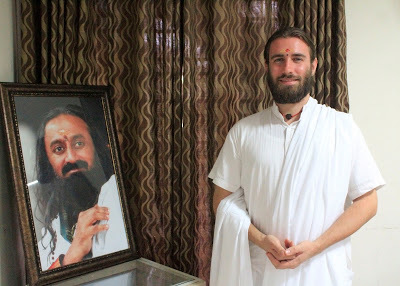 By Shevlin Sebastian
By Shevlin SebastianOn a recent Monday morning, Swami Purnachaitanya steps on to a foot-high concrete platform at the Art of Living Ashram in Kollam. He then puts his hands together in a namaste, bows his head towards the garlanded photograph of founder Sri Sri Ravi Shankar on the wall and then sits cross-legged in front of a low table covered by a white cloth. Two lighted lamps have been placed in front. Two priests are sitting on either side of the table. The audience consists of devotees, visitors and volunteers.
Swami Purnachaitanya then adjusts his shoulder-length hair, while, through the sound system, the words ‘Namo Namo’ are repeated.
Swami Purnachaitanya is about to perform the Rudra Puja, which is in honour of Lord Shiva. It is one of his favourite pujas. In 2004, he participated in his first Rudra puja at Bengaluru. “When I closed my eyes and listened to the mantra, my mind became calm,” he says. “Half an hour later, I was in a deep state of meditation.”
What is unusual about Swami Purnachaitanya is that he is from Holland (original name: Alexander Luthra). When was 16, he saw Sri Sri Ravi Shankar in a public meeting at Holland and was much impressed. “Some of the things Sri Sri Ravi Shankar said made a lot of sense,” says Swami Purnachaitanya. “He spoke about how we have a tendency to identify with our smaller identities, like being an architect or a member of a community. He said that one of the reasons for many of the problems with the world is that we identify with these small identities, and not with the bigger one that we are all human beings and part of the planet.”
Then, a few months later, Swami Purnachaitanya attended his first Art Of Living programme and was drawn to the meditation and breathing techniques that allowed him to calm his mind. Thereafter, he attended many other workshops.
During a gap year, after high school, Swami Purnachaitanya spent a couple of months doing volunteer work at the Art of Living headquarters in Bengaluru and was much impressed. Following his graduation in journalism, new media and Indology in 2007, he joined the ashram.
Today, he is Director of Programmes and International Faculty. And his work profile is to look after all the activities in the seven states of the North-East, as well as West Bengal. He also travels abroad, to give talks and conduct programmes in places like Hongkong, United Arab Emirates, Sri Lanka, Nepal, Bhutan and Europe.
Asked about the common problems facing people, Swami Purnachaitanya says, “Many people fulfill their ambitions of becoming rich, having a house and car and other comforts, but then they realise that it does not bring happiness. In fact, there is an inner emptiness.”
Another problem is that technology is overwhelming people. “You are being bombarded with messages and information all the time,” says Swami Purnachaitanya. “And it becomes difficult to process all this information. The whole society is speeding up. As a result, most people are exhausted. You sleep for eight hours and you wake up still feeling tired.”
Hence, Swami Purnachaitanya teaches people different methods to calm the mind. “The easiest way is by observing the breath,” says the Swami. “So, we teach the Sudarshan Kriya.”
This involves using cyclical breathing patterns: from slow, medium to rapid. In this way, you gain control of your breath; this has an immediate effect on your nerves, mind and immune system. There are four types of breaths: Ujjayi (Victorious Breath); Bhastrika (Bellows Breath); Om Chant, and Kriya (Purifying Breath).
As Swami Purnachaitanya speaks, it is difficult to believe that he is Dutch, because his accent is pure Indian. “That's because I have lived ten years in India,” he says. “Or maybe because I have 25 percent Indian DNA.”
The Swami's grandfather, who was from Delhi, married a Dutch woman. They had a daughter, as well as a son, but separated after a while. Thereafter, the mother went to Holland with the children. “My mother could not speak any Indian language at all because there was no direct exposure,” says Swami Purnachaitanya. “But India had always been in her DNA. And that is also the case with me.”
(The New Indian Express, Kochi and Thiruvananthapuram)
Published on December 20, 2017 00:31
December 18, 2017
Bindu Nair has set up the Kochi unit of 'A Ray Of Hope', a Coimbatore-based organisation which helps the victims of paediatric cancer
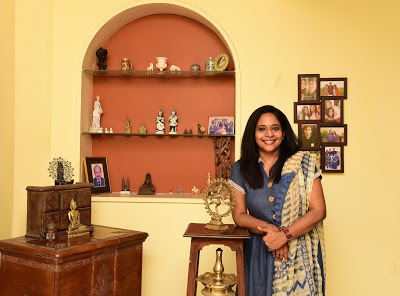
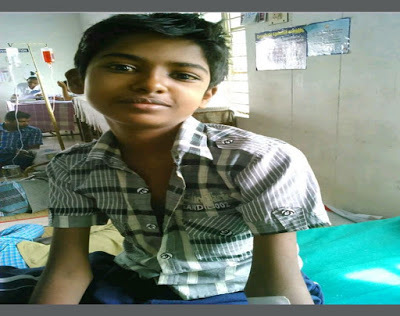
By Shevlin Sebastian
Photos: Bindu Nair. Pic by Albin Mathew; the late Arun Kumar
Twenty-eight riders on Harley Davidson motorbikes revved up their engines at the Durbar Hall ground at Kochi on a sunny September afternoon. All of them wore T-shirts with the legend, 'A Ray Of Hope' (AROH). Then Mollywood star Rima Kallungal swung a white flag. And the bikers moved off in a procession through the streets of Kochi.
Founder Bindu Nair, of the Coimbatore-based AROH wore a big smile. She had just opened her branch in Kochi. “I did so because there are so few centres in Kerala looking after children suffering from paediatric cancer,” says the 48-year-old Malayali (incidentally, AROH also stands for Arohan, the Sanskrit world for the ascending note in music).
What AROH does is provide medicines, free monthly rations, food at hospitals where the children are being treated, as well as psychological counselling for parents. Amazingly, she has already received a lot of support in Kochi. Apart from ten volunteers, the Hotel and Restaurant Owners' Association has agreed to provide free food at any hospital at Kochi. “They have promised to do it anywhere in Kerala,” says Bindu.
Parents need all the support they can muster, because the presence of cancer in their children has a devastating effect on them. “Their world comes crashing down,” says Bindu. “Very clearly, your life will never ever be the same again, whether the child survives or dies.”
Asked about the most common type of cancer, Bindu says, “It is acute lymphoblastic leukaemia.” The good news is that with timely treatment this cancer can be cured. In the US and the west, it is almost 95 per cent. But in India, it is only between 45 and 60 per cent. Since the majority of the patients belong to lower-middle-class families, they cannot afford the cost of the treatment, which could be anywhere between Rs 10 and 15 lakh. “Which middle-class family can afford that?” says Bindu. “Eventually, many children die.”
When that happens, the grief is unbearable for the parents. And they go through different stages of grief. “Firstly, there is a fierce anger towards God,” says Bindu. “All the mothers will tell immediately that they don't want to live anymore. There is a feeling of not knowing what to do next. For years, their sole focus had been the child. All of a sudden, one morning, they don't have anything to do.”
So AROH volunteers regularly visit them and provide bereavement counselling. “If need be, we call in psychologists too,” says Bindu. “Then over a period of a few years, there is an acceptance of the death. Slowly, because of the presence of other children, the parents are able to assert their will to move on.”
But the memories will remain forever. Even for Bindu who will always remember Arun Kumar who came from a very poor background. His father, a goldsmith, abandoned the family and went off with another woman.
When his mother protested, in anger, the father poured kerosene, and burnt her, in front of Arun. “Arun was suffering from cancer at that time,” says Bindu. “Soon after, his father also abandoned him and his younger sister. They were left in the care of their grandmother.”
There was no justice for the mother. At the police station, because the father paid the cops off, the death was registered as a suicide. “But what stands out in my mind was that, despite all the tragedies, I have never met a more outgoing and positive-minded person like Arun,” says Bindu. “Every moment that we spent with Arun was a learning experience for all of us. He was such an intelligent and outgoing boy.”
Arun passed away at age 15. “Because of Arun, I have learnt to cherish every moment of every day, because you can die at any time,” says Bindu.
(Sunday Magazine, The New Indian Express, South India and Delhi)
Published on December 18, 2017 22:42
December 17, 2017
The Luxembourg-born artist Sophie Medawar, of Lebanese origin, talks about her experiences in Kerala
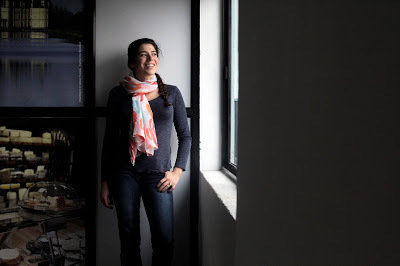
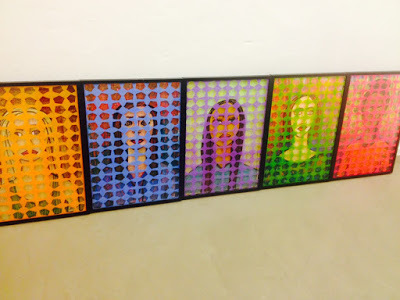
By Shevlin Sebastian
Photos: Sophie Medawar by MA Ramees; the art work, 'Cache-Cache'
When the Luxembourg-born Sophie Medawar, of Lebanese origin, was invited by a Malayali friend, at Kochi, for lunch on a Monday, she said, “I am sorry, it is the day when I am on a fast.”
Her friend said, “Is it because you are in Kerala?” But Sophie replied that she has always fasted on Monday, to give a rest to her body. “Later I came to know that there was a tradition that Malayali women would fast on a Monday in the hope of getting a good husband,” says Sophie, as she adds, with a smile. “But I am already married and have a daughter.”
Sophie first came to Kerala, with her family, in August, last year, and fell in love with the place. “Like Lebanon, which I visit several times a year, Kerala is a place where there are strong family bonds and people of different religions live peacefully together,” she says.
And she is an admirer of Kerala women. “They go to work, then they return in the evenings and take care of their family,” she says. “They educate their children so well. The women seem independent and free, but, while talking to them, I realised that there are restrictions which can be stifling: if you are not married by a certain age, if you don't want to get married, if you don't get pregnant soon after marriage, or if you are divorced, you are seen in a different way. This is the case in Lebanon, too, where the family plays a prominent role in society. So, in a way, there is not much freedom for women in both places.”
To highlight this lack of freedom, Sophie is getting a floor installation made at a studio in Cherookad, near Tripunithara. She has made brass pieces that look like mouths which have been shut up. More than 2000 pieces will be placed on the floor, one on top of the other. “These symbolise the taboos that a woman faces, all imposed by society, or by their own mindsets,” says Sophie. “But they cannot speak out. When people walk over these brass pieces, they will bang against each other and a sound will be made, like as if the women are being liberated.”
Women are Sophie's only subject. This interest began in her childhood. “I was always drawing girl’s faces,” she says. “That focus has continued till now. Women have this connection to mother earth because they themselves are mothers and creators of life.”In an earlier work, called 'Cache-Cache', she has painted portraits of women from all over the world. These images have been framed and Sophie has drawn an ‘Oriental pattern’, with small squares, in acrylic paint, on the exterior glass, to give an indication of a barrier. “Again, this is to show the lack of freedom,” says Sophie.
Her art is usually expressed through paintings or installations. For paintings, she uses beeswax. “I warm the wax, and mix it with natural pigments,” she says. “I paint while the wax is still warm. Otherwise, it becomes hard.” For her installations, she uses brass, copper, wood and glass. And she spends long hours at her studio in Luxembourg.
“That's because art is my life, passion and destiny,” she says. “I regard it as an inner expression. It is not something to hang up between the curtain and the sofa. It is much more than that. Art is divine. And it should open the eyes and soul of the people.”
Meanwhile, despite living in affluent and art-conscious Europe, it has not been easy to survive as an artist. “But I cannot think of any other way to lead my life,” says Sophie, who at 5’10’, and clad in a grey top and jeans, cuts an elegant figure. But Indian influences are already at work. She wraps a multi-coloured shawl around her neck. “Everything is so colourful in Kerala: the clothes, houses and food,” she says. “I am enjoying being colourful myself.”
(The New Indian Express, Kochi and Thiruvananthapuram)
Published on December 17, 2017 22:24
December 15, 2017
A Portrait
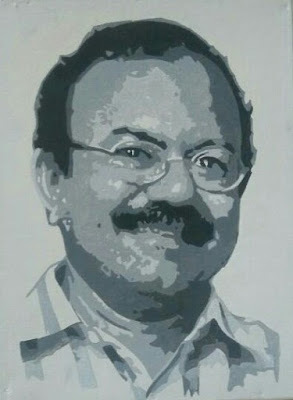 Artist O. Sunder's portrait of yours truly.
Artist O. Sunder's portrait of yours truly.Such a rare experience: a journalist being a subject.
Thank you very much Sunder Sir
Published on December 15, 2017 01:19
December 12, 2017
Hiding Under The Bed
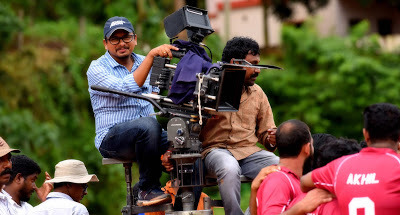
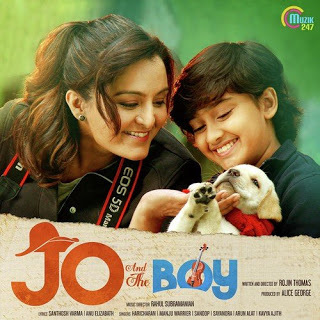 COLUMN: LOCATION DIARY
COLUMN: LOCATION DIARYCinematographer Neil D’Cunha talks about his experiences in the films, 'Philips and The Monkey Pen', ‘Jo and The Boy’ and 'Kochavva Paulo Ayyappa Coelho'
Photos: Cinematographer Neil D'Cunha; Manju Warrier, Sanoop Santhosh and the dog Charlia in 'Jo And The Boy'
By Shevlin Sebastian
The time was 9.15 p.m. The producer of 'Philips and The Monkey Pen' (2013) wanted the shoot to conclude by 9.30 p.m. The scene was inside a bedroom at a house in Kochi. Four boys were supposed to be in the scene. They were Sanoop Santhosh, Gaurav Menon, Aakhash Santhosh and Antony D'Silva. But the boys could not be found anywhere. “Crew members searched all the rooms of the house, as we waited in the bedroom,” says cinematographer Neil D'Cunha. “They went outside too, but the boys were missing.”
Time was running out. But, in the end, the boys were discovered hiding under the bed in the room where everybody was waiting. “We did not know whether to give them a spanking or box their ears,” says Neil with a laugh. Anyway, the shooting resumed.
On another day, the shoot was at Varkala Beach, near Thiruvananthapuram. Sanoop had to sit on a log looking pensive. The camera was at the edge of a jib. The idea was to get a long shot from a height.
As the shoot progressed, a huge wave appeared suddenly and went over the jib. As a result, the camera fell into the water. “My heart went into my mouth,” says Neil. It was the expensive Red Epic camera.
But thankfully, because of the sand, there was a soft landing. There was no major damage. “We took the camera apart, part by part, and laid the pieces out in the sun to dry,” says Neil.
Suddenly, somebody shouted, “Where is Sanoop?”
He was not on the beach. In fact, the wave had taken him towards the sea. They could see him on the log at some distance. Crew members rushed into the sea to get him back.
Meanwhile, once the pieces got dry, shooting resumed. “There were problems for the next two days,” says Neil. “The camera would over-heat. And we would lose about 40 minutes of shooting every day waiting for it to cool down.”
In the end, Neil got in touch with the US office of Red Epic. Soon, they upgraded the software online. “Thereafter, the camera started working fine,” says Neil.
In 'Jo and the Boy' (2015), the crew faced problems of a different kind. The shoot was on a cliff at Kodaikanal. “It was an introduction scene,” says Neil. “The scene was being shot at 10.30 p.m. But since it was in the month of December it was extremely cold.”
Suddenly, a breeze began to blow. “It was so chilly that all of us began to shiver,” says Neil. “I could not hold the camera straight because I was shaking so much. And the Labrador Charlie who had to walk on to a table just would not come out of his kennel.”
So, the shoot was put off for the next night. But the next night, the same thing happened. It was biting cold. Neil half-jokingly suggested to the director Rojin Thomas that maybe the scene could be re-written. But Rojin did not agree.
In the end, a set was built at Navodaya Studio at Kakkanad, Kochi. “We did the shoot two weeks later, and you will not notice the difference,” says Neil.
For the film 'Kochavva Paulo Ayyappa Coelho' (2016), Neil had a completely different experience. During the shoot, Neil had acquired an S6 Samsung. “I would look after it very carefully,” says Neil. “When I had to do a shoot, I would give it to my assistants and tell them not to put it in their trouser pockets but in their bags. In case, they were sitting against a wall, with their bag on their backs, I would tell them to sit forward.”
One day, Neil wore Bermuda shorts and put the phone in his pocket. Suddenly, he got a call from a colourist’s firm in Chennai. They said they liked the rushes. Neil felt happy and excited. Then he went to a pond, where a swimming sequence had to be shot. “I placed the camera in the pond and stepped into the water,” says Neil “And I forgot all about the phone in my pocket.”
It got completely wet. On Facebook, Neil had seen a video of placing a wet smartphone inside a bowl of rice grains in order to dry it out. He did it, but nothing happened. The phone did not work. So, he sent it to the Samsung company. “They said the phone had been spoiled completely and nothing could be done about it,” says Neil. “Despite all the precautions I took, in the end, Rs 36,000 went down the drain.”
(The New Indian Express, Kochi, Thiruvananthapram and Kozhikode)
Published on December 12, 2017 22:49
December 10, 2017
“We Should Agree To Disagree”

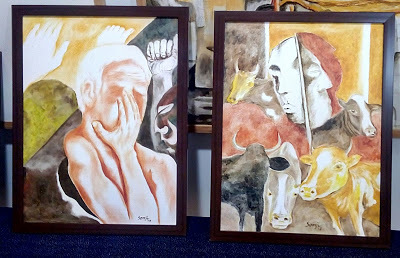 Artist Somji, a former Deputy Commissioner (Taxes), talks about his exhibition, 'Identity of Tolerance'
Artist Somji, a former Deputy Commissioner (Taxes), talks about his exhibition, 'Identity of Tolerance'By Shevlin Sebastian
Photos by Ramees MA
In his terrace art gallery, at his home behind the sprawling campus of the Cochin University of Science and Technology, at Kochi, KA Soman (Artist Somji) is busy getting his works ready. Some have already been framed, others yet to be. His exhibition, titled 'Identity of Tolerance', which is being held at the Durbar Art Gallery, from December 12-17, will consist of as much as 70 paintings. But they have all been done in the abstract style.
One striking image is of an old man, with his right hand covering his nose and mouth. Standing next to him is a woman in a black shroud. Behind her, there are raised hands almost pleading for help. On the right, there is another hand which looks like it is raised in protest.
“The ordinary man is horrified by what is happening in the country now,” says Somji. “He probably knew about a tolerant India earlier. Now he is feeling ashamed of what is happening.”
The retired Deputy Commissioner (Taxes) continues, “Tolerance is a very relevant theme these days not only in India but all over the world. A lot of atrocities are being done in the name of tolerance. For example, the insistence of singing the national anthem, the over-protection of the cow, hyper-nationalism, the suppression of free expression, and the insistence of eating only particular types of food. People are also prescribing the way you can dress. So, they are frowning on T-shirts and jeans.”
In another work, there are several cows crowding the frame in front. Behind it are two faces with grim expressions. “The cow has become the dominant motif in our national discourse,” says Somji. “In north India, the cow is being deified. It is an animal which gives us a lot of milk, and other benefits. But to raise it to a divine level, will cause problems. India has a huge and diverse population, so the only way to move forward is to consider the views of all the people.”
But the airing of views has become a fraught affair. “When we express a point of view, there are people who will oppose you vehemently,” says Somji. “Many times, they use violence. This has been exemplified by the murder of journalist Gauri Lankesh. I believe that one should agree to disagree so that all views can be aired. We have to formulate new ideas through discussions and mutual understanding. But that is not happening at the moment.”
In another work, a couple is looking at each other. But staring at them is a man who does not look pleased at all. There is also an image of a man who is wearing a full-sleeved shirt, but who has the face of a rhinocerosis with the horns sticking out from the face. A person standing next to him has the same horns. At the side, there are two women who are kneeling and praying.
“The rulers are pretending to be human beings, but they are rhinos, ready to use their tusks, and shed blood, to achieve their aims,” says Somji. “They are building a society where people have to be like rhinos in order to survive. As for the women, they are kneeling and praying to their forefathers. I also wanted to show that in a male-dominated society they will always remain in the background.”
Besides most of the paintings, Somji is planning to put up telling quotations by great people. One is by the spiritual leader, the Dalai Lama, who said, “In the practice of tolerance, one's enemy is the best teacher.” Noted educationist Helen Keller had said, “The highest result of education is tolerance.” As for the Father of the Nation, this is what Mahatma Gandhi said: “Intolerance is itself a form of violence and an obstacle to the growth of a true democratic spirit.”
This exhibition makes us aware of the direction the country is moving.
(The New Indian Express, Kochi and Thiruvananthapuram)
Published on December 10, 2017 20:51
December 5, 2017
A Senior Bureaucrat Remembers
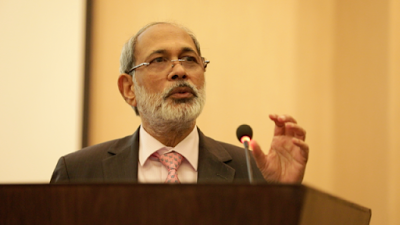
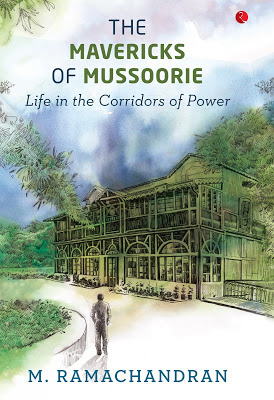 M. Ramachandran has written a memoir of his 38-year service in the Indian Administrative Service
M. Ramachandran has written a memoir of his 38-year service in the Indian Administrative ServiceBy Shevlin Sebastian
In the 1990s, at Meerut, the Governor had come on a visit. According to protocol, he was lodged at the main Circuit House. At the same time, a central minister had come visiting and was put up in an annexe. It affected the minister's ego. In front of everybody, the minister shouted at the Divisional Commissioner M. Ramachandran, although this was not under his purview. Ramachandran was deeply anguished and wrote a letter to the Chief Secretary apprising him of this incident.
This incident was recounted in Ramachandran's memoir, 'The Mavericks of Mussoorie' (Life in the corridors of power). Today, decades later, Ramachandran still keenly feels the humiliation of that moment. And during the panel discussion following the book release, recently, at New Delhi, retired senior bureaucrats like TSR Subramanian, BK Chaturvedi, Amitabh Kant and others did talk about the need for a code of conduct for politicians, just as it is there for members of the civil services. “This discussion should be taken forward,” says Ramachandran.
This well-written memoir is a must-read for all those who are entering the service or beginning their careers. It gives a clear picture of the problems a bureaucrat can face, and the ways to solve them, as well as the pulls and pressures from politicians and the public. It can also be interesting to others.
'For the general reader, the book is a chance to acquaint themselves more intimately with how the Indian Administrative Service or the bureaucracy functions,' writes Ramachandran in the preface. 'All too often it is assumed that civil servants lead cushy and luxurious lives. People are quick to feel frustrated with bureaucracy and failures in governance, but I think the book will provide a perspective and an understanding of the multi-layered challenges of functioning within a layered and structured system.'
Indeed it does. Apart from that, there are nuanced portraits of leaders like Narain Dutt Tiwari, S. Jaipal Reddy, Rajiv Gandhi, Arun Nehru and Kalyan Singh.
And not surprisingly, there are interesting anecdotes. On December 6, 1992, the day the Babri Masjid fell, Ramachandran received a call from a batch-mate who was posted in another state, seeking immediate help for troubled family members who belonged to a minority community and were being targeted. He immediately passed on instructions to the local administration to make sure that that protection was provided.
'Such was the bonding of batch mates in the All India Services; this colleague knew he could count on immediate help and relief being provided,' wrote Ramachandran. 'I would have come to the help of any other such person as well, but the question was how many people would have been able to contact me directly, like my batch mate?'
In another time, when he was personal secretary to Arun Nehru, who was a minister of state for internal security, Mother Teresa came visiting at North Block. And Ramachandran accompanied her to the Customs Board located on the other side of the building. 'After some time, while on her way back, she made it a point to walk back to my office just to thank me and present me with a small memento,' writes Ramachandran. 'I was greatly touched. This was very gracious of her. I felt happy I could be of some help to this rarest of rare human beings dedicated to the service of humanity.'
Ramachandran describes many other experiences, the numerous developmental works, his stint in the United Nations Development Programme as well as his stay at the University of Glasgow where he did his M.Phil in Economic Planning. Eventually, he secured a doctorate from the University of Lucknow.
After a 38-year-service, Ramachandran reached the post of Secretary, the Central Ministry of Urban Development. And he was all set to reach the apex post of Cabinet Secretary. But he experienced a major disappointment, when the incumbent received an unprecedented extension, resulting in a four-year term.
“It is a sad reflection of the decision-making process,” says Ramachandran, who retired in 2010 and stays in Delhi. “But I knew that I had to move on.” Today, he is the Chairperson of the Indian Heritage Cities Network Foundation, Chairman of the National Urban Transport Awards Committee, as well as a chancellor of a university.
It has been a life well-lived.
Title: The Mavericks of Mussoorie – Life In The Corridors of Power'
Author: M. Ramachandran
Publisher: Rupa
Pages: 307
Price: Rs 395
(The New Indian Express, Kochi and Thiruvananthapuram)
Published on December 05, 2017 02:06
December 3, 2017
A Taste That Grows On You
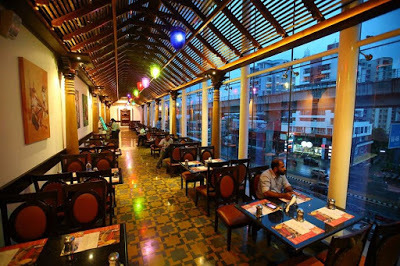
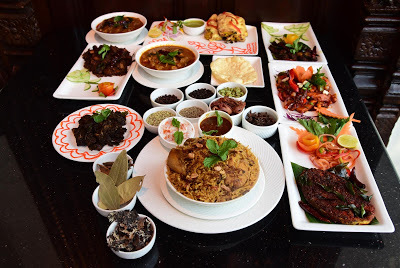
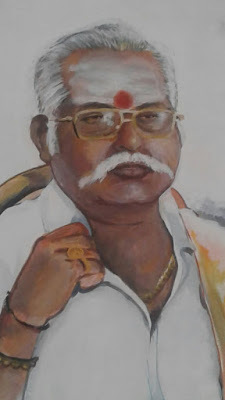
So good was chef Anjappar that Tamil Nadu superstar MG Ramachandran hired him on the spot. Today, the Anjappar restaurant chain, which has opened its first unit in Kochi, is going from strength to strength
Photos: The inside of the Anjappar restaurant at Lulu Mall, Kochi; a variety of items; the late founder Anjappar
By Shevlin Sebastian
Malayalam singer Madhu Balakrishnan was very happy when the Anjappar restaurant opened at the Lulu Mall, Kochi, a few months ago. “I have been a fan since long,” he says. “Whenever I would have music programmes in places like Dubai and Singapore, I would always go to have the Chettinad food.” (this is the cuisine of the Nattukotai Chettiars, who belong to the Chettinad region of Tamil Nadu).
Asked the reason for his liking, Madhu says, “It is light on the stomach. And the food has a different taste.”
This is affirmed by the Food and Beverages Head S. Gandhinathan. “Our base is black pepper and spices, instead of masala powder,” he says. “To get the best spices we buy from wholesalers, instead of retail outlets. And to maintain quality, we grind the spices ourselves. Our USP is that we use different spices for every dish.”
So, for the mutton sukka dish, the spices used include cinnamon, cloves and pepper cumin. But for the chicken dishes, it is chilly and coriander. Some of the other spices, which are used, include star aniseed, tamarind, fennel seeds, fenugreek, as well as curry leaves and peppercorn.
“We also use a lot of shallots (small onions),” says Gandhinathan. “It makes the dishes tastier.” For a first-time visitor, there is an initial feeling of the food being a bit hot, but gradually the taste grows on you. And, indeed, at the end of the meal, you don’t feel heavy at all.
According to Gandhinathan, the most popular dishes are the special Chettinad meals, as well as the different varieties of dum biriyani: chicken, fish, prawn and mutton. “In fact, the biriyani is very popular abroad,” he says.
There are Anjappar restaurants in the USA, Australia, Singapore, Malaysia, United Arab Emirates, Oman, Kuwait, Bahrain, Qatar and Saudi Arabia, while, in India, the majority are in Tamil Nadu, Karnataka, Pondicherry, and now, the 79th outlet in Kerala.
In Kochi, interestingly, most of the Malayali customers who come, have already had meals at Anjappar restaurants while working in West Asia. There are also Mollywood stars like Aju Varghese, Mamta Mohandas Asif Ali, Vineeth Sreenivasan and former cricketer S Sreesanth who are regulars. In the comments book, Sreesanth wrote, 'Amazing food and service'.
A life-changing move
When the founder Anjappar left the village of Ponnamaravathy, in the Chettinad region of Tamil Nadu, with his family, to Chennai, 400 kms away, in the 1950s, to better his economic prospects, little could he have imagined that his life would turn out the way it did.
What helped was Anjappar's natural talent for cooking and a fateful meeting with the colossus of Tamil Nadu, the filmstar MG Ramachandran, on the sets of a film, where Anjappar was providing the food. “MGR Sir liked Anjappar Sir's food so much that he immediately hired him as his personal chef,” says Gandhinathan. Thereafter, he worked in MGR's kitchen for the next 20 years. Then, with the blessings of the superstar, he ventured out and started his first restaurant in Royapettah in 1964. And never looked back.
The success story has continued for decades. Unfortunately, Anjappar passed away on January 7, 2001. Now his two sons, Kandasamy and Maruthu Pandian are running the show. “We are focused on expanding our chain,” says Kandasamy. With their unique taste, success seems to be assured.
(Sunday Magazine, The New Indian Express, South India and Delhi)
Published on December 03, 2017 22:11
December 1, 2017
Trying To Change The Mindset
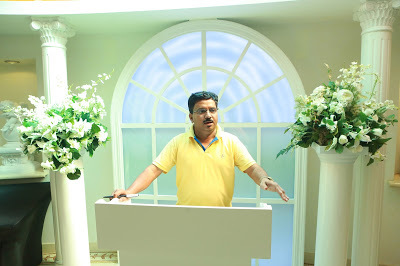
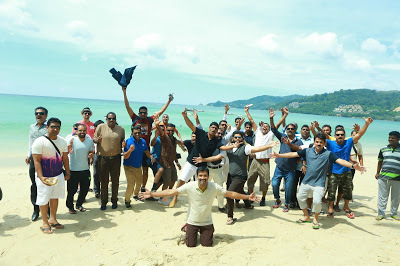 Manjeri Nasser, with his Idea Factory group, is on a mission to make people change for the better
Manjeri Nasser, with his Idea Factory group, is on a mission to make people change for the betterPhotos: Manjeri Nasser; members on their first Caribbean cruise
By Shevlin Sebastian
It was a Caribbean cruise from Kochi. More than 50 people from North Kerala were on the ship. They were making their first trip overseas trip to Malaysia, Singapore and Thailand. They came from different backgrounds: artists, businessmen, teachers, IT executives and entrepreneurs, all in the age range of 23 to 40. While there, they interacted with the local businessmen, as well as administrators and bureaucrats. They were led by businessman Manjeri Nasser and his 99 Idea Factory CCD team (CCD= Collection, Coordination and Distribution).
“For the group, the trip was a revelation,” says Nasser. “They met people with completely different attitudes. As a result, they could better understand our Malayali mindset.”
And what is that mindset? “Malayalis have a lot of common sense but they lack professionalism,” he says. “We have an attitude problem. We will not allow anybody to do anything good nor will we appreciate it when something nice is done. Instead, we tend to look for faults.”
And we take our freedom for granted. “One person takes the freedom of one-and-a-half people,” says Nasser. “There is a lack of productivity among the people. And we don't have a vision for our life. If I ask somebody, 'what are your aims for 2030'?, nine times out of ten, they will have no answer.”
For Nasser, the best visionary was the late Prime Minister Jawaharlal Nehru. “Thanks to his far-reaching thinking, he was able to set up the Indian Institute of Management and many other institutions all over the country. In Singapore, too, the administrators have a long-term vision. And they do their work aligned with this.”
Through the Idea Factory, the Manjeri-based businessman wants to change the attitude of the people. So Nasser holds a 'Salute to the Seniors' programme, where successful people talk about their life experiences and take questions from the audience. “If we spend two hours with a 70-year-old man and can get an idea of his experiences and life lessons, it will be very helpful to us,” says Nasser.
Some of the speakers included the collage artist Manu Kallikad, the Limca Book record holder, CP Kunjumohammed, chairman of Iqraa hospital, as well as motivational expert Santosh Nair.
After attending Santosh's one-day workshop, an ordinary farmer by the name of Rafeeq Shah (name changed) felt that he had an entrepreneurial gift. He started a business in steel rods and it took off. Now, Rafiq has 32 branches all over Kerala. So, some people have made dramatic changes.
Another programme is called the Positive Circle programme. Again, the aim is to change the mindset of Malayalis. “90 percent of the people who live in the state have a negative attitude,” he says. At this moment, the programme is taking place in Manjeri, Malappuram, Kozhikode and Kochi. But Nasser wants to spread it all over Kerala. “Interestingly, most of the attendees tend to have a positive attitude,” says Nasser. “The others stay away.”
He has taken the concept to Dubai, where again about 400 people took part in a four-day seminar of talks, discussions and ideas.
Meanwhile, Nasser has just returned from a trip to Germany, Holland, Switzerland, Belgium and France. “Our next trip is Idea Tour Europe,” he says. This will take place next May, and 40 people will comprise the group.
“There will be different types of interactions, apart from sight-seeing,” says Nasser. “I believe the 12-day tour will help develop a new mindset among the participants.”
(The New Indian Express, Kochi, Thiruvananthapuram and Kozhikode)
Published on December 01, 2017 21:44
November 26, 2017
Hopes And Worries
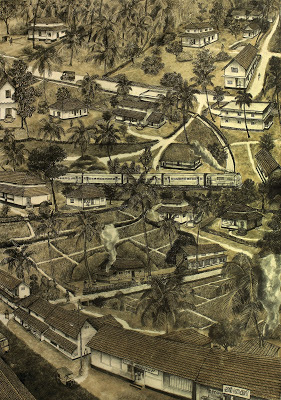
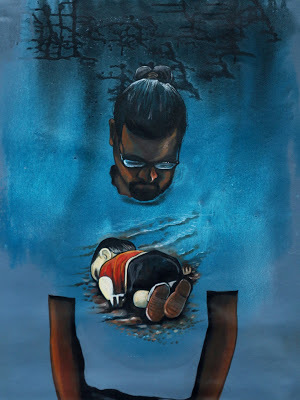

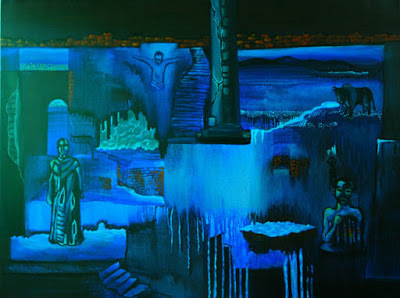 At the inaugural exhibition, at the Onyx Art Gallery at Mattancherry, 31 artistes are displaying an intriguing variety of moods and thought processes
At the inaugural exhibition, at the Onyx Art Gallery at Mattancherry, 31 artistes are displaying an intriguing variety of moods and thought processesPhotos: Jagesh Edakkad’s graphite pencil drawing, 'A Glance To The Past'; Varghese Kalathil’s ‘Self-portrait with burning memories’, work by Sunil Asokapuram
By Shevlin Sebastian
A glance at artist Jagesh Edakkad’s graphite pencil drawing, 'A Glance To The Past', brings a smile to one’s face. It is a drone-like view of a village: the typical tiled houses of Kerala, with smoke billowing from chimneys. The narrow roads have very little traffic. There are numerous coconut trees, apart from paddy fields, dotting the landscape. There is the familiar bakery shop, a hotel and not, to forget, the ubiquitous toddy shop. And a train in the middle bifurcates the canvas neatly.
“It is a moment of nostalgia for me,” says the Kochi-based Jagesh. “This is an image of my village in Kannur. Nowadays, all the places are crowded and polluted. I wanted to show a village that was neat and environmentally-clean.”
He has memories of going to the bakery shop as well as the toddy shop as a child. “I would go and get fresh toddy so that my mother could make appams,” he says.
In complete contrast is Varghese Kalathil’s ‘Self-portrait with burning memories’. It shows two portraits side by side of the pony-tailed Varghese. In one he is looking downwards. Right in the middle of the chest, there is an image of a lifeless child in a red sweater. This is the world-famous image of the three-year-old Aylan Kurdi lying lifeless on a beach in the Greek island of Kos. Along with his parents, they were trying to escape to Europe on a boat from Syria when the boy drowned.
In the second portrait, Varghese has drawn the back of his body. This time, there is an image of a thin girl, with protruding limbs, with face bent, almost pressing into the mud, but looking in a state of agony. A vulture stands close by. This was a Pulitzer-Prize winning photograph, which was taken by the South African photojournalist, Kevin Carter, while on assignment to Sudan in 1993, where a civil war was taking place.
“There was a famine in the area,” says Varghese. “People were dying. The vulture was also waiting for the child to die so that it could eat her.” Unfortunately, Kevin was deeply affected by what he had seen in Sudan. The 33-year-old committed suicide a year later because of depression.
“I want to tell the truths of life,” says Varghese. “I am not very much bothered if the work does not sell. As for this particular work, I don't think anybody would like to put up in their homes. But I am okay with it.”
Another sombre work is that of Sreeja Pallam’s ‘Dirge of a Soil’ Through a broken wall, you can see a semi-naked woman clutching the dark brown mud. Next to her are the openings of two empty canisters pressed into the mud.
“The woman is a representative of Mother Nature,” says Sreeja. “I wanted to show that nature is being shattered. We are reaching a stage where the water cannot even penetrate the mud. We seem to have no address on this earth.”
Sunil Asokapuram is equally worried. In his acrylic on canvas, there is a person at the back of the painting with his arms upraised. “This is to reflect the crucified Jesus Christ to show the state of mankind,” he says. “We are being crucified by all sorts of problems.”
In the middle of the painting, there is a broken down pillar. “Again this is a metaphor to show the broken state of our society, politics, and the loss of belief worldwide in ideology and human beings,” says Sunil.
However, he has not lost all hope. At the side, there is an image of a man whose opened chest reveals a lamp burning. “This painting can elevate life for the viewer, and so can music, books and films,” he says. “There is always a space for good things to happen.”
A total of 31 artists are taking part in this inaugural exhibition of the Onyx Art Gallery at Mattancherry, which has been started by artists Onyx Paulose and Sara Hussein.Almost all the works are impressive including those by OC Martin, Babitha Rajive, Robert Lopez, Baby KG, Devadas, Sajith Puthukkalavattom, Tom Vattakkuzhiy, Suresh Koothuparambau, Sreelal and Manoj Narayanan.
Curator O. Sundar said that he did not suggest any theme to the artists. “I wanted them to feel free,” he says. The artists have been invited from the districts of Kannur, Kozhikode, Malappuram, Thrissur, Ernakulam, Allapuzha, Kollam and Thrissur. “Many of them are unable to get a space to display their works at Kochi, the art capital,” says Sundar. “So I wanted to give them an opportunity.”
(The New Indian Express, Kochi and Thiruvananthapuram)
Published on November 26, 2017 21:46



